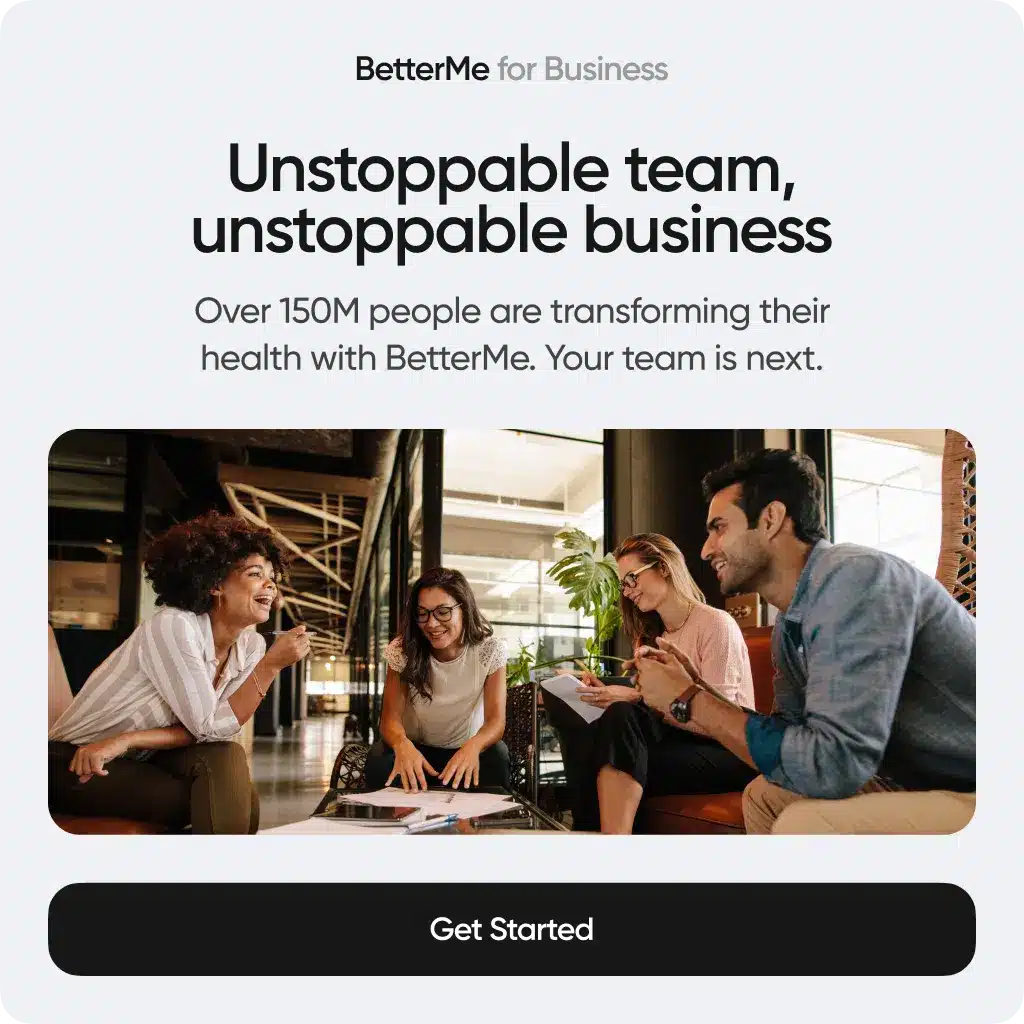Summer can bring unique challenges for workplace productivity. Warmer days, longer evenings, and vacation schedules can leave employees feeling sluggish at work. For leaders, finding ways to help employees stay energized while respecting the nuances of workplace dynamics is essential.
According to the World Health Organization, a healthy lifestyle involves a balance between mental, physical, and social well-being (1). With that in mind, here are 10 summer wellness activities to help employees stay energized throughout the season.
How Do Seasonal Wellness Activities Affect Productivity?
A survey by the Society for Human Resource Management found that 63% of employees reported feeling more motivated and engaged when employers offered wellness programs. In addition to boosting morale, seasonal wellness activities can also improve overall productivity in the workplace (2).
Here are some ways that engaging in healthy summer activities can positively impact employee productivity:
Boosting Morale Through Seasonal Engagement
Summer wellness activities, such as team picnics, outdoor yoga sessions, or step challenges, create opportunities for fun and bonding.
Employees who participate in these feel more connected to their teams and the company culture. This sense of belonging can lead to higher morale, which research has shown to be directly linked to increased productivity (3).
When employees are given opportunities to engage in enjoyable, stress-reducing activities, they’re more likely to approach their work with enthusiasm. For example, organizing a summer social event allows employees to decompress while building camaraderie. This balance of relaxation and connection often translates into refreshed energy when they return to their tasks (4).
BetterMe has excellent tools for your business all in one place: a personalized approach to health and wellness, 1,500 workouts for every fitness level, a variety of meal plans and trackers to satisfy any dietary needs, mental health guides, and employer support. Discover all the options now!
Harnessing Energy with Outdoor Activities
Exposure to natural light and fresh air has been proven to increase focus and energy levels (5). Seasonal outdoor activities capitalize on this. Encouraging employees to hold meetings outside, take walking breaks, or join group fitness sessions in the park boosts mood and also refreshes concentration (4).
Scientific studies have shown that time spent in green spaces improves cognitive function and reduces mental fatigue (6). Employees who have opportunities to step away from their desks and engage with the outdoors are more likely to return to work with greater clarity and problem-solving abilities.
Elevating Physical and Mental Health
The summer season naturally lends itself to activities that promote physical movement, from bike rides to walking challenges. Physical wellness doesn’t just benefit the body, it also stimulates the mind. Exercise increases blood flow to the brain, improves mood by releasing endorphins, and reduces stress levels (7).
BetterMe offers a 28-day walking challenge that can help your team stay active throughout the summer. Join and take the first step toward a healthier, more active lifestyle.
Similarly, incorporating mental health-focused activities can sustain the energy of employees throughout the summer. For example, offering mindfulness sessions or relaxation breaks during peak stress periods can prevent burnout (8). When employees are healthier and less stressed, they’re better able to focus, innovate, and work efficiently.
Counteracting Seasonal Productivity Slumps
For some employees, productivity dips in summer due to long days, warm weather, or vacation schedules. Seasonal wellness activities help balance these trends by fostering structure and routine without draining their energy. Small initiatives, such as summer hydration stations or flexible work hours, allow employees to stay engaged without feeling overwhelmed.
In particular, flexible hours allow employees to work during their most productive times of the day. For example, an early riser may prefer to start and end their workday earlier to make the most of the sunshine, while others may feel energized if they work later into the evening (9).
Encouraging Positive Habits That Last
One of the long-term advantages of seasonal wellness programs is that they often inspire positive habits beyond the summer months.
For example, initiating a workplace fitness challenge may encourage employees to continue exercising year-round. Healthier, happier employees are more productive and less likely to take sick days (10).
By fostering these habits, leaders can see a sustained impact on productivity and transform short-term activities into ongoing benefits.
Read more: Summer Wellness Tips: Take Care of Your Health Right
What Are the Benefits of Summer Wellness Activities for Employees?
Summer wellness activities can be more than just a seasonal perk for your employees. They offer opportunities to boost physical health, nurture mental well-being, and enhance social connections.
These activities:
- Encourage more movement – Outdoor activities such as walking challenges or yoga sessions promote regular physical activity, which boosts energy and reduces stress (7).
- Reduce health risks – Fitness initiatives help lower the risk of chronic conditions, which leads to fewer sick days and a healthier workforce (11).
- Relieve mental fatigue – Outdoor breaks and mindfulness sessions recharge employees, which reduces workplace stress and improves concentration (6, 8).
- Prevent burnout – Relaxation-focused activities, such as guided meditation or chair massages, help employees manage stress and maintain morale (8).
- Boost teamwork and camaraderie – Participating in group activities promotes teamwork and communication, in addition to building positive relationships between colleagues (12)
Can Summer Wellness Activities Improve Employee Retention?
According to a 2022 report from the International Foundation of Employee Benefit Plans, 76% of organizations found their wellness initiatives to be effective in improving employee retention, with 12% rating them as very effective and 62% as somewhat effective (13).
Employees want to feel supported in their job roles and their overall well-being. Summer wellness activities cater to this need by aligning organizational priorities with the personal well-being and work-life balance of employees.
For example, initiatives such as flexible summer work hours or outdoor team-building events show employees that their time, health, and happiness are valued. These programs help create a positive association with the workplace, which improves their likelihood of staying.
Furthermore, today’s workforce evaluates potential employers based on how they treat employees. The World Economic Forum reported in 2023 that 58% of millennials and Gen Z workers consider wellness programs to be a significant factor when deciding on a job offer (14).
So robust wellness strategies don’t just benefit current employees, they also make organizations more attractive.
What Are Some Wellness Activities to Boost Employees’ Energy?
1. Encourage Movement During the Workday
Physical activity is a proven way to increase energy levels. Regular movement increases blood circulation, delivering oxygen and nutrients to the brain and muscles. This can help employees shake off sluggishness and refocus on their tasks (15).
Research also indicates that how employees spend their breaks matters (4). Passive scrolling on phones often leaves people feeling more drained, while engaging in meaningful or physical activities can boost energy.
For workplaces, small bursts of movement can be realistic and effective:
- Schedule 10-minute group stretching sessions mid-morning or mid-afternoon. These times align with natural energy dips in our circadian rhythms.
- Suggest “walk-and-talk” meetings. This combines purposeful activity with collaboration.
- Equip office spaces with sit-stand desks, giving employees the option to stretch their legs throughout the day.
- Onsite games such as foosball or cornhole to foster activity and social connection.
- Quiet zones with books, puzzles, or relaxation chairs for those who need mental downtime.
Research supports that even light physical activity enhances energy and reduces feelings of fatigue (15). By integrating these micro-movement opportunities, leaders can create a workspace that fosters natural energy boosts without major disruptions.
You can boost your team’s well-being and productivity by using BetterMe’s Zoom app which enables you to integrate quick warmup and stretching sessions into your workday. Access BetterMe’s wellness content right in Zoom to create a calmer, more connected team experience.
2. Leverage Natural Light
Sunlight exposure directly impacts energy levels and alertness. The human body produces serotonin, a neurotransmitter that stabilizes mood and boosts energy, in response to natural light. In addition, sunlight helps regulate circadian rhythms, which improves sleep quality (16).
For offices with limited windows, consider these tactics:
- Organize outdoor brainstorming sessions or “sunlight breaks”.
- Allow flexible schedules, encouraging employees to align breaks with sunlight hours.
- If outdoor access isn’t feasible, full-spectrum light bulbs or lamps that mimic natural light can make an indoor space feel brighter and more energizing.
By making small adjustments, leaders can maximize light exposure, which can help employees feel more awake and alert during the day.
3. Provide Accessible, Healthy Snacks
Nutrition plays a major role in maintaining energy levels. Processed foods or sugary snacks lead to spikes in energy followed by inevitable crashes, leaving employees more fatigued. On the other hand, foods that are rich in protein, complex carbohydrates, and healthy fats provide sustained energy (17).
To support employees:
- Stock break rooms with easily accessible options such as mixed nuts, fresh fruit, and whole-grain snacks.
- Partner with local businesses or cafes to deliver nutritious meals or snacks during summer hours.
- Host a “nutrition lunch and learn” with a dietitian to educate teams about foods that sustain energy.
Research underscores the connection between nutrition and workplace performance (18). By providing access to better food choices, employees can maintain a stable energy level throughout the day.
4. Promote Hydration
Dehydration is a common but often overlooked cause of fatigue (19). Particularly during warmer months, employees are at higher risk of mild dehydration, which can lead to reduced focus, headaches, and sluggishness.
Practical solutions include:
- Installing water stations or water bottle refill stations in easily accessible locations.
- Offering reusable branded water bottles as part of a summer wellness initiative.
- Adding hydration boosters such as infused water with lemon, cucumber, or berries to make drinking water more appealing.
- Implementing a water leaderboard, a fun and motivational tool used to track and rank participants based on how much water they drink over a certain period.
Educating employees about the role of hydration in maintaining energy can also help instill lasting habits. Keeping everyone well-hydrated can counteract the energy dips that are associated with summer heat.
5. Integrate Mindfulness Breaks
Mindfulness has been shown to reduce stress and improve mental alertness (8). When employees feel frazzled or overwhelmed, energy takes a hit.
Workplace applications can include:
- Offering guided meditation during lunch breaks or streaming mindfulness exercises via apps such as Calm or Headspace.
- Creating a quiet room or relaxation area specifically for short mindfulness practices or decompression.
- Using email or internal communication channels to remind employees to pause for a 2-3 minute mindful breathing exercise during peak stress periods.
These moments of stillness don’t require a significant time commitment but can have a noticeable impact on employee energy and focus.
6. Offer Flexible Work Hours
Some employees may feel more energetic earlier or later in the day, often dictated by personal chronotypes. During summer, long daylight hours can make this variability more pronounced.
Allowing flexible starts or remote options can better align work schedules with individual energy peaks. For example:
- An employee who struggles with mornings could start later and work into the evening when they feel most productive.
- Teams could experiment with compressed workweeks during the summer months, giving employees longer weekends to recharge.
Research in workplace productivity consistently highlights that flexibility improves energy and overall job satisfaction (9). By adjusting schedules, you’ll give employees the freedom to work when they’re at their best.
7. Create a Culture of Gratitude and Positivity
Workplace culture has a direct influence on how energized employees feel. Fostering positivity through gratitude can help mitigate summer stresses and improve overall morale (20).
Ideas include:
- Implementing a gratitude wall, where employees can post notes recognizing teammates.
- Hosting casual weekly check-ins to share wins and recognize contributions.
- Building gratitude exercises into meetings, such as taking the first 2 minutes to acknowledge positive team efforts.
Studies have shown that practicing gratitude increases dopamine levels, which enhance energy and motivation. Focusing on the positives, even during busy summer months, can elevate the workplace mood and energy levels. To learn more about the gratitude challenge, check out our in-depth article on the topic.
8. Encourage Outdoor Team Activities
Spending time outdoors has well-documented energizing effects. Exposure to green spaces reduces mental fatigue, improves focus, and enhances overall well-being (6).
To bring employees outdoors, you could:
- Organize casual team-building events such as hiking, outdoor yoga, or a picnic in a local park.
- Introduce “Fresh Air Friday” where meetings or brainstorming sessions take place outside.
- Sponsor a summer workplace challenge, such as steps or cycling contests, that encourages outdoor movement.
These efforts don’t just increase energy levels, they also strengthen team dynamics, which can boost collaboration and morale.
9. Educate Employees About Sleep Hygiene
Though sleep happens outside work hours, its effects are undeniable during workdays. Sleep deprivation is a major factor in low energy and reduced productivity (21).
Employers can address this by:
- Hosting seminars or sending tips on establishing sleep-friendly routines, such as limiting screen time before bed.
- Providing resources about relaxation techniques or sleep-focused apps.
- Adjusting start times or remote work policies to allow better alignment with the sleep needs of employees.
Empowering employees to prioritize rest can have ripple effects on their daytime energy and engagement.
How Can You Tailor Wellness Activities to Different Preferences?
Every employee is unique, and their approach to wellness often reflects their personalities, lifestyles, and needs. By tailoring wellness activities, HR leaders can ensure higher engagement and inclusivity. Here’s how you can effectively address these differences:
Offer a Variety of Options
One size does not fit all when it comes to wellness. Employees have different preferences for how they unwind, recharge, or manage stress.
- Physical Activities
While some employees enjoy group fitness classes, others may prefer solo activities such as yoga or walking. Offer a mix of virtual fitness subscriptions, onsite group workouts, and outdoor challenges to cater to different comfort levels. - Mindfulness Practices
Not everyone connects with meditation. Some may find journaling or listening to calming music more effective. Provide multifaceted mental wellness tools through apps or workshops and allow employees the freedom to choose what works best. - Social vs. Individual Activities
Extroverts may thrive in team-based events such as trivia nights or charity runs. At the same time, introverts might prefer quiet wellness-focused perks, such as reading nooks or individual relaxation pods. Create balance by offering a blend of social and solo opportunities.
Research has shown that offering choice boosts participation (22). Employees are more likely to engage when they feel they have control over selecting what resonates with them.
An individual approach to the fitness, nutrition, and mental health of your employees, together with BetterMe employer support – you’ve got everything at your fingertips. What are you waiting for? Access all the benefits now!
Use Employee Feedback as a Guide
A personalized approach starts with understanding employee preferences. Collect data through:
- Surveys and Polls
Use simple, anonymous surveys to learn what employees value in a wellness program. For example, ask about their interest in different activities such as fitness, nutrition, or mental health. - Focus Groups
Engage employees more deeply by hosting conversations about what would genuinely motivate them to participate.
By tailoring activities to match stated preferences, you boost inclusivity and also demonstrate attentiveness to employee needs.
Be Sensitive to Cultural and Personal Considerations
Cultural practices, disabilities, or personal beliefs may shape how an employee engages in wellness. For example:
- Not all employees may practice yoga due to religious concerns. Consider providing alternatives such as general stretching or cardio.
- Employees with mobility challenges may prefer low-impact physical activities or seated fitness sessions.
Equipping wellness initiatives with inclusive options ensures no one feels left out or pressured to participate in something uncomfortable.
Create Flexible Scheduling
Busy schedules can be a barrier to participation. By offering wellness activities at multiple times across the day or week, employees can find options that fit around their work and personal responsibilities. On-demand and remote wellness programs (e.g. video content or app access) are particularly effective for providing this flexibility (9).
Personalization doesn’t need to be overwhelming. A data-driven approach, coupled with variety, ensures wellness efforts are accessible, meaningful, and impactful for everyone on your team.
Read more: 7-Day Workplace Mental Wellness Challenge: Small Habits, Big Impact
What’s the Best Way to Measure the Impact of These Activities?
Tracking the success of wellness programs helps leaders identify what’s working and improve efficiency. This isn’t just about showing return on investment (ROI), it’s about understanding how these initiatives truly benefit employees. Here’s how you can evaluate impact effectively:
Monitor Employee Engagement
Engagement metrics provide insights into how many employees are using the resources you’ve provided:
- Participation Rates
Measure attendance at events, enrollment in programs, or app usage levels. A quick uptick in participation shows your wellness efforts are gaining traction. - Feedback and Suggestions
Send short, anonymous post-event surveys to understand employee satisfaction. Ask specific questions such as, “Did this session help you address stress?” to gauge effectiveness. - Retention Over Time
Reevaluate participation levels after the initial launch. Steady or growing interest indicates sustained value, while declining numbers suggest you may need to revise offerings.
Look at Workplace Performance Indicators
Wellness programs that work often influence broader workplace metrics. By pairing participation data with workplace outcomes, you’ll have a clearer sense of impact:
- Reduction in Absenteeism
Employees who feel healthier and more supported may miss fewer workdays. Compare absenteeism rates before and after launching wellness initiatives. - Employee Turnover Rates
A positive wellness culture fosters loyalty. Reduced turnover can reflect the success of your efforts.
One multinational company found that offering onsite fitness classes and meditation significantly improved attendance and reduced sick days.
Assess Employee Well-Being
Use tools to directly measure how employees feel about their wellness:
- Pulse Surveys
Short, frequent surveys offer real-time insights into how workplace stress or morale is aligned with wellness initiatives. - Health Risk Assessments (HRAs)
Periodic health checkups can establish trends in key health indicators, such as blood pressure or cholesterol, before and after program implementation. - Happiness or Energy Scales
Integrating questions about perceived energy levels or workplace satisfaction into annual reviews can tie wellness activities to mental and emotional factors.
Beyond hard data, anecdotal insights can also provide valuable context. Positive comments, improved teamwork, and general enthusiasm signal that wellness efforts are leaving a tangible mark.
Calculate Cost Savings
Effective wellness programs are often aligned with long-term cost reductions. Focus on measurable financial impacts:
- Lower healthcare claims due to improved employee health.
- Reduced expenses on recruitment and training as retention improves.
Workplace wellness studies frequently tie lower healthcare costs to initiatives such as smoking cessation, stress management, or fitness incentives.
Measure Incrementally and Be Patient
It’s important to set realistic timelines for achieving measurable results. While some metrics, such as participation rates, can be monitored quickly, others such as improved health metrics may take months or years to reflect meaningful change.
Establish baseline measurements early and track the results regularly to understand progress over time. This also lets you make evidence-based adjustments to optimize programming as needed.
Yes, both walking meetings and stretch breaks have proven benefits. Walking meetings encourage creative thinking by increasing blood flow to the brain, and they help reduce sedentary behavior, which is linked to health risks like obesity and cardiovascular disease. Stretch breaks combat muscle stiffness, improve posture, and boost energy levels. Research has shown that even short activity breaks can improve focus and productivity throughout the workday. Offering events consistently throughout the summer, such as weekly or bi-weekly, strikes a balance between frequency and engagement. Regular activities keep wellness top-of-mind without overwhelming employees’ schedules. For example, hosting a fitness class every Thursday or planning a monthly outdoor team-building activity allows employees to anticipate and participate meaningfully. Small teams can implement impactful wellness initiatives without significant cost, such as: These ideas foster engagement and well-being without straining a limited budget. To secure leadership support, present a clear business case for wellness programs. Highlight data such as reduced absenteeism, increased productivity, and lower healthcare costs associated with wellness activities. Share case studies from similar organizations and emphasize ROI, including improved employee retention and satisfaction. Partnering with HR to conduct a pilot program can also demonstrate measurable value, building leadership buy-in for expansion.Frequently Asked Questions
Can walking meetings or stretch breaks make a difference?
How often should you offer summer wellness events?
What low-budget wellness ideas can small teams use?
How do you get leadership to support wellness programs?
The Bottom Line
Summer wellness activities for employees are more than just seasonal perks, they’re valuable tools that enhance both individual and team performance. From boosting morale and promoting physical activity to fostering stronger workplace bonds, these initiatives can contribute to a thriving, engaged workforce.
DISCLAIMER:
This article is intended for general informational purposes only and does not serve to address individual circumstances. It is not a substitute for professional advice or help and should not be relied on for making any kind of decision-making. Any action taken as a direct or indirect result of the information in this article is entirely at your own risk and is your sole responsibility.
BetterMe, its content staff, and its medical advisors accept no responsibility for inaccuracies, errors, misstatements, inconsistencies, or omissions and specifically disclaim any liability, loss or risk, personal, professional or otherwise, which may be incurred as a consequence, directly or indirectly, of the use and/or application of any content.
You should always seek the advice of your physician or other qualified health provider with any questions you may have regarding a medical condition or your specific situation. Never disregard professional medical advice or delay seeking it because of BetterMe content. If you suspect or think you may have a medical emergency, call your doctor.
SOURCES:
- Health as Complete Well-Being: The WHO Definition and Beyond (2023, academic.oup.com)
- Wellness Program Benchmarks Highlighted in SHRM Survey (2015, shrm.org)
- What Is Employee Engagement and How Do You Improve It? (n.d., gallup.com)
- “Give me a break!” A systematic review and meta-analysis on the efficacy of micro-breaks for increasing well-being and performance (2022, pmc.ncbi.nlm.nih.gov)
- Natural Light and Productivity: Analyzing the Impacts of Daylighting on Students’ and Workers’ Health and Alertness (2016, researchgate.net)
- Residential Green Space and Cognitive Function in a Large Cohort of Middle-Aged Women (2022, pmc.ncbi.nlm.nih.gov)
- Exercise and mental health (2023, healthdirect.gov.au)
- The Effects of Mindfulness Meditation on Stress and Burnout in Nurses (2021, journals.sagepub.com)
- Work Flexibility and Work-Related Well-Being (2021, mdpi.com)
- Healthy employees are more productive (2024, cignaglobalhealth.com)
- Physical activity, exercise, and chronic diseases: A brief review (2019, pmc.ncbi.nlm.nih.gov)
- Group Activities: Enhancing Team Collaboration (2024, culturepartners.com)
- Looking to Improve Retention? These 15 Wellness Offerings May Do the Trick. (2022, blog.ifebp.org)
- Future of Jobs Report 2023 (2023, www3.weforum.org)
- The Effect of Chronic Exercise on Energy and Fatigue States: A Systematic Review and Meta-Analysis of Randomized Trials (2022, frontiersin.org)
- Effect of sunlight and season on serotonin turnover in the brain (2002, sciencedirect.com)
- A Critical Review on the Role of Food and Nutrition in the Energy Balance (2020, mdpi.com)
- Assessing the Impact of Workforce Nutrition Programmes on Nutrition, Health and Business Outcomes: A Review of the Global Evidence and Future Research Agenda (2023, mdpi.com)
- Adult Dehydration (2025, ncbi.nlm.nih.gov)
- The science of happiness at work: How positive psychology can increase productivity (2023, lpsonline.sas.upenn.edu)
- How Sleep Affects Your Health (2022, nhlbi.nih.gov)
- Improving participation rates by providing choice of participation mode: two randomized controlled trials (2015, bmcmedresmethodol.biomedcentral.com)












